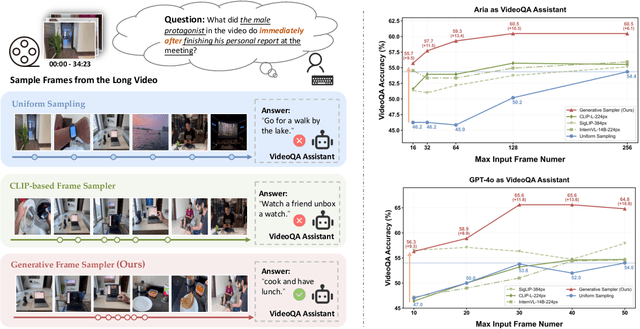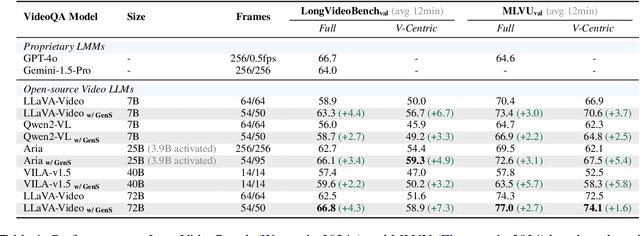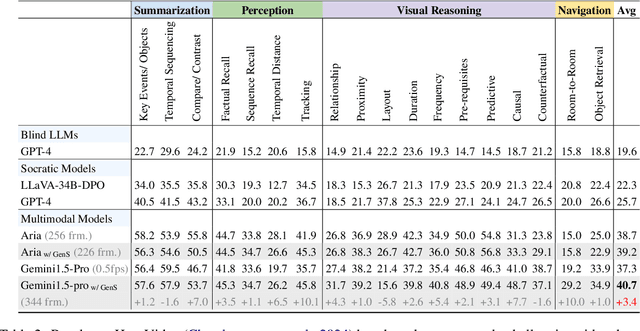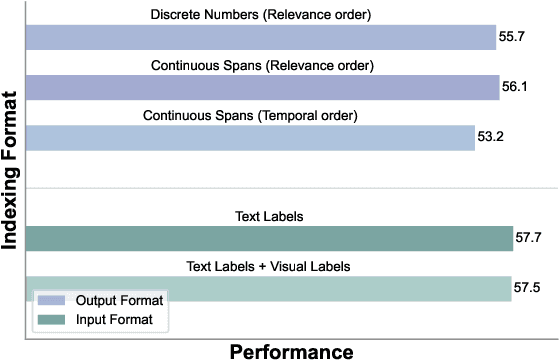Linli Yao
Mitigating Overthinking through Reasoning Shaping
Oct 10, 2025Abstract:Large reasoning models (LRMs) boosted by Reinforcement Learning from Verifier Reward (RLVR) have shown great power in problem solving, yet they often cause overthinking: excessive, meandering reasoning that inflates computational cost. Prior designs of penalization in RLVR manage to reduce token consumption while often harming model performance, which arises from the oversimplicity of token-level supervision. In this paper, we argue that the granularity of supervision plays a crucial role in balancing efficiency and accuracy, and propose Group Relative Segment Penalization (GRSP), a step-level method to regularize reasoning. Since preliminary analyses show that reasoning segments are strongly correlated with token consumption and model performance, we design a length-aware weighting mechanism across segment clusters. Extensive experiments demonstrate that GRSP achieves superior token efficiency without heavily compromising accuracy, especially the advantages with harder problems. Moreover, GRSP stabilizes RL training and scales effectively across model sizes.
RICO: Improving Accuracy and Completeness in Image Recaptioning via Visual Reconstruction
May 28, 2025Abstract:Image recaptioning is widely used to generate training datasets with enhanced quality for various multimodal tasks. Existing recaptioning methods typically rely on powerful multimodal large language models (MLLMs) to enhance textual descriptions, but often suffer from inaccuracies due to hallucinations and incompleteness caused by missing fine-grained details. To address these limitations, we propose RICO, a novel framework that refines captions through visual reconstruction. Specifically, we leverage a text-to-image model to reconstruct a caption into a reference image, and prompt an MLLM to identify discrepancies between the original and reconstructed images to refine the caption. This process is performed iteratively, further progressively promoting the generation of more faithful and comprehensive descriptions. To mitigate the additional computational cost induced by the iterative process, we introduce RICO-Flash, which learns to generate captions like RICO using DPO. Extensive experiments demonstrate that our approach significantly improves caption accuracy and completeness, outperforms most baselines by approximately 10% on both CapsBench and CompreCap. Code released at https://github.com/wangyuchi369/RICO.
RICo: Refined In-Context Contribution for Automatic Instruction-Tuning Data Selection
May 18, 2025Abstract:Data selection for instruction tuning is crucial for improving the performance of large language models (LLMs) while reducing training costs. In this paper, we propose Refined Contribution Measurement with In-Context Learning (RICo), a novel gradient-free method that quantifies the fine-grained contribution of individual samples to both task-level and global-level model performance. RICo enables more accurate identification of high-contribution data, leading to better instruction tuning. We further introduce a lightweight selection paradigm trained on RICo scores, enabling scalable data selection with a strictly linear inference complexity. Extensive experiments on three LLMs across 12 benchmarks and 5 pairwise evaluation sets demonstrate the effectiveness of RICo. Remarkably, on LLaMA3.1-8B, models trained on 15% of RICo-selected data outperform full datasets by 5.42% points and exceed the best performance of widely used selection methods by 2.06% points. We further analyze high-contribution samples selected by RICo, which show both diverse tasks and appropriate difficulty levels, rather than just the hardest ones.
ICon: In-Context Contribution for Automatic Data Selection
May 08, 2025Abstract:Data selection for instruction tuning is essential for improving the performance of Large Language Models (LLMs) and reducing training cost. However, existing automated selection methods either depend on computationally expensive gradient-based measures or manually designed heuristics, which may fail to fully exploit the intrinsic attributes of data. In this paper, we propose In-context Learning for Contribution Measurement (ICon), a novel gradient-free method that takes advantage of the implicit fine-tuning nature of in-context learning (ICL) to measure sample contribution without gradient computation or manual indicators engineering. ICon offers a computationally efficient alternative to gradient-based methods and reduces human inductive bias inherent in heuristic-based approaches. ICon comprises three components and identifies high-contribution data by assessing performance shifts under implicit learning through ICL. Extensive experiments on three LLMs across 12 benchmarks and 5 pairwise evaluation sets demonstrate the effectiveness of ICon. Remarkably, on LLaMA3.1-8B, models trained on 15% of ICon-selected data outperform full datasets by 5.42% points and exceed the best performance of widely used selection methods by 2.06% points. We further analyze high-contribution samples selected by ICon, which show both diverse tasks and appropriate difficulty levels, rather than just the hardest ones.
TimeChat-Online: 80% Visual Tokens are Naturally Redundant in Streaming Videos
Apr 24, 2025Abstract:The rapid growth of online video platforms, particularly live streaming services, has created an urgent need for real-time video understanding systems. These systems must process continuous video streams and respond to user queries instantaneously, presenting unique challenges for current Video Large Language Models (VideoLLMs). While existing VideoLLMs excel at processing complete videos, they face significant limitations in streaming scenarios due to their inability to handle dense, redundant frames efficiently. We introduce TimeChat-Online, a novel online VideoLLM that revolutionizes real-time video interaction. At its core lies our innovative Differential Token Drop (DTD) module, which addresses the fundamental challenge of visual redundancy in streaming videos. Drawing inspiration from human visual perception's Change Blindness phenomenon, DTD preserves meaningful temporal changes while filtering out static, redundant content between frames. Remarkably, our experiments demonstrate that DTD achieves an 82.8% reduction in video tokens while maintaining 98% performance on StreamingBench, revealing that over 80% of visual content in streaming videos is naturally redundant without requiring language guidance. To enable seamless real-time interaction, we present TimeChat-Online-139K, a comprehensive streaming video dataset featuring diverse interaction patterns including backward-tracing, current-perception, and future-responding scenarios. TimeChat-Online's unique Proactive Response capability, naturally achieved through continuous monitoring of video scene transitions via DTD, sets it apart from conventional approaches. Our extensive evaluation demonstrates TimeChat-Online's superior performance on streaming benchmarks (StreamingBench and OvOBench) and maintaining competitive results on long-form video tasks such as Video-MME and MLVU.
Generative Frame Sampler for Long Video Understanding
Mar 12, 2025



Abstract:Despite recent advances in Video Large Language Models (VideoLLMs), effectively understanding long-form videos remains a significant challenge. Perceiving lengthy videos containing thousands of frames poses substantial computational burden. To mitigate this issue, this paper introduces Generative Frame Sampler (GenS), a plug-and-play module integrated with VideoLLMs to facilitate efficient lengthy video perception. Built upon a lightweight VideoLLM, GenS leverages its inherent vision-language capabilities to identify question-relevant frames. To facilitate effective retrieval, we construct GenS-Video-150K, a large-scale video instruction dataset with dense frame relevance annotations. Extensive experiments demonstrate that GenS consistently boosts the performance of various VideoLLMs, including open-source models (Qwen2-VL-7B, Aria-25B, VILA-40B, LLaVA-Video-7B/72B) and proprietary assistants (GPT-4o, Gemini). When equipped with GenS, open-source VideoLLMs achieve impressive state-of-the-art results on long-form video benchmarks: LLaVA-Video-72B reaches 66.8 (+4.3) on LongVideoBench and 77.0 (+2.7) on MLVU, while Aria obtains 39.2 on HourVideo surpassing the Gemini-1.5-pro by 1.9 points. We will release all datasets and models at https://generative-sampler.github.io.
Temporal Reasoning Transfer from Text to Video
Oct 08, 2024



Abstract:Video Large Language Models (Video LLMs) have shown promising capabilities in video comprehension, yet they struggle with tracking temporal changes and reasoning about temporal relationships. While previous research attributed this limitation to the ineffective temporal encoding of visual inputs, our diagnostic study reveals that video representations contain sufficient information for even small probing classifiers to achieve perfect accuracy. Surprisingly, we find that the key bottleneck in Video LLMs' temporal reasoning capability stems from the underlying LLM's inherent difficulty with temporal concepts, as evidenced by poor performance on textual temporal question-answering tasks. Building on this discovery, we introduce the Textual Temporal reasoning Transfer (T3). T3 synthesizes diverse temporal reasoning tasks in pure text format from existing image-text datasets, addressing the scarcity of video samples with complex temporal scenarios. Remarkably, without using any video data, T3 enhances LongVA-7B's temporal understanding, yielding a 5.3 absolute accuracy improvement on the challenging TempCompass benchmark, which enables our model to outperform ShareGPT4Video-8B trained on 28,000 video samples. Additionally, the enhanced LongVA-7B model achieves competitive performance on comprehensive video benchmarks. For example, it achieves a 49.7 accuracy on the Temporal Reasoning task of Video-MME, surpassing powerful large-scale models such as InternVL-Chat-V1.5-20B and VILA1.5-40B. Further analysis reveals a strong correlation between textual and video temporal task performance, validating the efficacy of transferring temporal reasoning abilities from text to video domains.
UBiSS: A Unified Framework for Bimodal Semantic Summarization of Videos
Jun 24, 2024



Abstract:With the surge in the amount of video data, video summarization techniques, including visual-modal(VM) and textual-modal(TM) summarization, are attracting more and more attention. However, unimodal summarization inevitably loses the rich semantics of the video. In this paper, we focus on a more comprehensive video summarization task named Bimodal Semantic Summarization of Videos (BiSSV). Specifically, we first construct a large-scale dataset, BIDS, in (video, VM-Summary, TM-Summary) triplet format. Unlike traditional processing methods, our construction procedure contains a VM-Summary extraction algorithm aiming to preserve the most salient content within long videos. Based on BIDS, we propose a Unified framework UBiSS for the BiSSV task, which models the saliency information in the video and generates a TM-summary and VM-summary simultaneously. We further optimize our model with a list-wise ranking-based objective to improve its capacity to capture highlights. Lastly, we propose a metric, $NDCG_{MS}$, to provide a joint evaluation of the bimodal summary. Experiments show that our unified framework achieves better performance than multi-stage summarization pipelines. Code and data are available at https://github.com/MeiYutingg/UBiSS.
* Accepted by ACM International Conference on Multimedia Retrieval (ICMR'24)
DeCo: Decoupling Token Compression from Semantic Abstraction in Multimodal Large Language Models
May 31, 2024



Abstract:The visual projector, which bridges the vision and language modalities and facilitates cross-modal alignment, serves as a crucial component in MLLMs. However, measuring the effectiveness of projectors in vision-language alignment remains under-explored, which currently can only be inferred from the performance of MLLMs on downstream tasks. Motivated by the problem, this study examines the projector module by interpreting the vision-language semantic flow within MLLMs. Specifically, we trace back the semantic relevance flow from generated language tokens to raw visual encoder patches and the intermediate outputs produced by projectors. Our findings reveal that compressive projectors (e.g., QFormer), abstract visual patches into a limited set of semantic concepts, such as objects or attributes, resulting in a 'double abstraction' phenomenon. This involves a first visual semantic abstraction by the projector referring to pre-defined query tokens, and a second extraction by the LLM based on text instructions. The double abstraction is inefficient in training and will result in cumulative vision semantics deficiency. To mitigate this issue, we propose the key insight of 'Decouple Compression from Abstraction (DeCo), that is compressing the visual token number at the patch level by projectors and allowing the LLM to handle visual semantic abstraction entirely. Consequently, we adopt a simple compressor, i.e., 2D Adaptive Pooling, to downsample visual patches in a parameter-free manner. Empirical evaluation demonstrates that DeCo surpasses traditional compressive projectors regarding both performance and efficiency. It achieves performance gains of 0.9%, 7.1%, and 2.9% across the MLLM Benchmarks, Visual Localization, and Open-ended VQA tasks with fewer trainable parameters and faster convergence speed.
LaDiC: Are Diffusion Models Really Inferior to Autoregressive Counterparts for Image-to-Text Generation?
Apr 16, 2024



Abstract:Diffusion models have exhibited remarkable capabilities in text-to-image generation. However, their performance in image-to-text generation, specifically image captioning, has lagged behind Auto-Regressive (AR) models, casting doubt on their applicability for such tasks. In this work, we revisit diffusion models, highlighting their capacity for holistic context modeling and parallel decoding. With these benefits, diffusion models can alleviate the inherent limitations of AR methods, including their slow inference speed, error propagation, and unidirectional constraints. Furthermore, we identify the prior underperformance of diffusion models stemming from the absence of an effective latent space for image-text alignment, and the discrepancy between continuous diffusion processes and discrete textual data. In response, we introduce a novel architecture, LaDiC, which utilizes a split BERT to create a dedicated latent space for captions and integrates a regularization module to manage varying text lengths. Our framework also includes a diffuser for semantic image-to-text conversion and a Back&Refine technique to enhance token interactivity during inference. LaDiC achieves state-of-the-art performance for diffusion-based methods on the MS COCO dataset with 38.2 BLEU@4 and 126.2 CIDEr, demonstrating exceptional performance without pre-training or ancillary modules. This indicates strong competitiveness with AR models, revealing the previously untapped potential of diffusion models in image-to-text generation.
 Add to Chrome
Add to Chrome Add to Firefox
Add to Firefox Add to Edge
Add to Edge